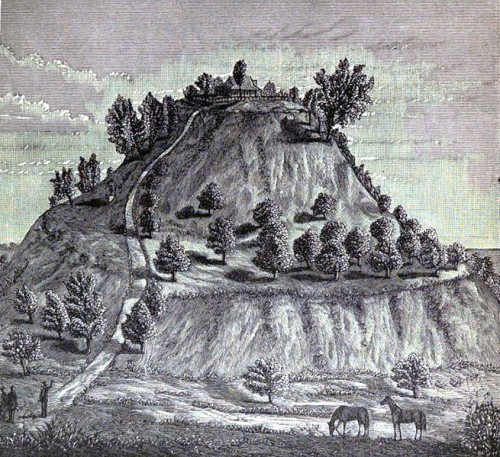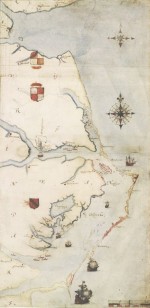Cahokia

It’s hard to believe there was a city in the U.S. that outnumbered any other in population, that was larger than even London at one point, that served as the biggest urban center north of Mexico – and that lots of us have never even heard of.
It’s Cahokia, Illinois, about 15 minutes away from St. Louis, Missouri. It was inhabited for about 700 years and was home to up to 20,000 people when it peaked from 1050-1200. More than 120 “mounds” were built for ceremonial purposes and to provide a prestigious spot for temples and the homes of chiefs.
Lots of interesting things have been discovered in excavations at Cahokia over the years. It even had its own Stonehenge – in fact, maybe up to five of them. Dubbed “Woodhenge,” archaeologists think the early residents of Cahokia used red cedar posts stuck in deep pits to mark days and events. One of them has been reconstructed for tourists to the Cahokia area.
Other advancements found include a copper workshop and watchtowers.
A slightly more disturbing discovery was hundreds of skeletons, including a mass grave of more than 50 women who were about the same age. Another mass grave was found containing both men and women, some of whom where apparently buried alive. It’s believed that they were sacrificial victims.
All of these signs of thriving civilization have to make you wonder: what the heck happened? How does a city go from being one of the largest in the world to being practically nonexistent in less than 200 years? Well… we don’t really know. There are plenty of theories, from widespread disease to political collapse. But since the people who lived there left absolutely no written record, we have no idea what actually happened. We also don’t know who these early people were – although we know all about the French missionaries who settled in the area in 1699 and the monks who made the mounds their home in 1809, it’s still not known what Native American tribes might be descendants of those early people.
Roanoke
 If you think it’s a little eerie that an entire city could slowly dwindle to nothingness like Cahokia did, consider that the Roanoke Colony of present-day North Carolina dwindled to nothingness seemingly overnight. More than 20 years before Jamestown was founded, the English Colony of Roanoke was set up with about 100 households. But the colony wasn’t thriving and leader Sir Richard Grenville shipped back to England with the promise of returning with more supplies to sustain the colony. When he came back, he discovered that the majority of the town had abandoned it, heading back to England with Sir Francis Drake when he offered to take them back with him after a brief visit.
If you think it’s a little eerie that an entire city could slowly dwindle to nothingness like Cahokia did, consider that the Roanoke Colony of present-day North Carolina dwindled to nothingness seemingly overnight. More than 20 years before Jamestown was founded, the English Colony of Roanoke was set up with about 100 households. But the colony wasn’t thriving and leader Sir Richard Grenville shipped back to England with the promise of returning with more supplies to sustain the colony. When he came back, he discovered that the majority of the town had abandoned it, heading back to England with Sir Francis Drake when he offered to take them back with him after a brief visit.In 1587, a second attempt was made to settle at Roanoke. Nearly 120 colonists settled in at the island and tried to establish friendly relations with the nearby tribe, but to no avail. The tribe had bad experiences with the original group of colonists and refused to meet with the new batch. After one of the settlers was killed while out hunting for crabs alone, the settlers began to fear for their lives and sent their governor back to England to ask for supplies and assistance. Due to various circumstances, Governor White didn’t make it back to Roanoke until three years later. When he finally did make it back, he discovered that the entire town was essentially gone – people, houses and all. Knowing that relations with the Native Americans in the area were pretty hostile, White told the colonists that they should leave him a sign if they had to relocate against their will or were under distress. The sign was supposed to be a Maltese cross carved on a certain tree. There was no Maltese cross on the tree, but there was something: the word “Croatoan” carved into what was left of the fort and “Cro” carved into a tree.
Governor White never found his Lost Colony, nor did any trace of them ever show up anywhere. But there’s no shortage of theories as to what may have happened to the settlers, but here are the five most popular:
- The colonists simply left and settled elsewhere. And took all of their houses with them. And left no word on where they had moved to. And were never found by anyone ever again. Hmm.
- Disease swept the island and killed everyone off. It also ravaged the buildings and apparently left no bodies.
- A hurricane did away with the whole colony. The trouble with this theory is that the fence surrounding the settlement was perfectly intact even though the houses were gone, and if a hurricane was powerful enough to wipe out the whole village without a trace, it surely would have claimed the fence as well.
- The colonists became friendly with a Native American tribe called the Croatans and moved to Croatoan Island to live with them, theorizing that they had a better chance of survival that way. Some historians think this is probable since there is some evidence of a friendly relationship between the Croatans and the colonists. It does, however, seem odd that the colonists were so cryptic with their “Croatoan” message instead of leaving a more detailed explanation.
- Another tribe of Native Americans (not the Croatans) annihilated the entire colony to serve as a warning to others. This is a pretty strong contender in the list of plausible explanations, but this theory has its problems too. If the entire colony was being mass murdered by a vengeful group of Native Americans, why wasn’t the distress signal carved into a tree? And who would have taken the time to carve “Croatoan” into a tree during this melee?

No comments:
Post a Comment